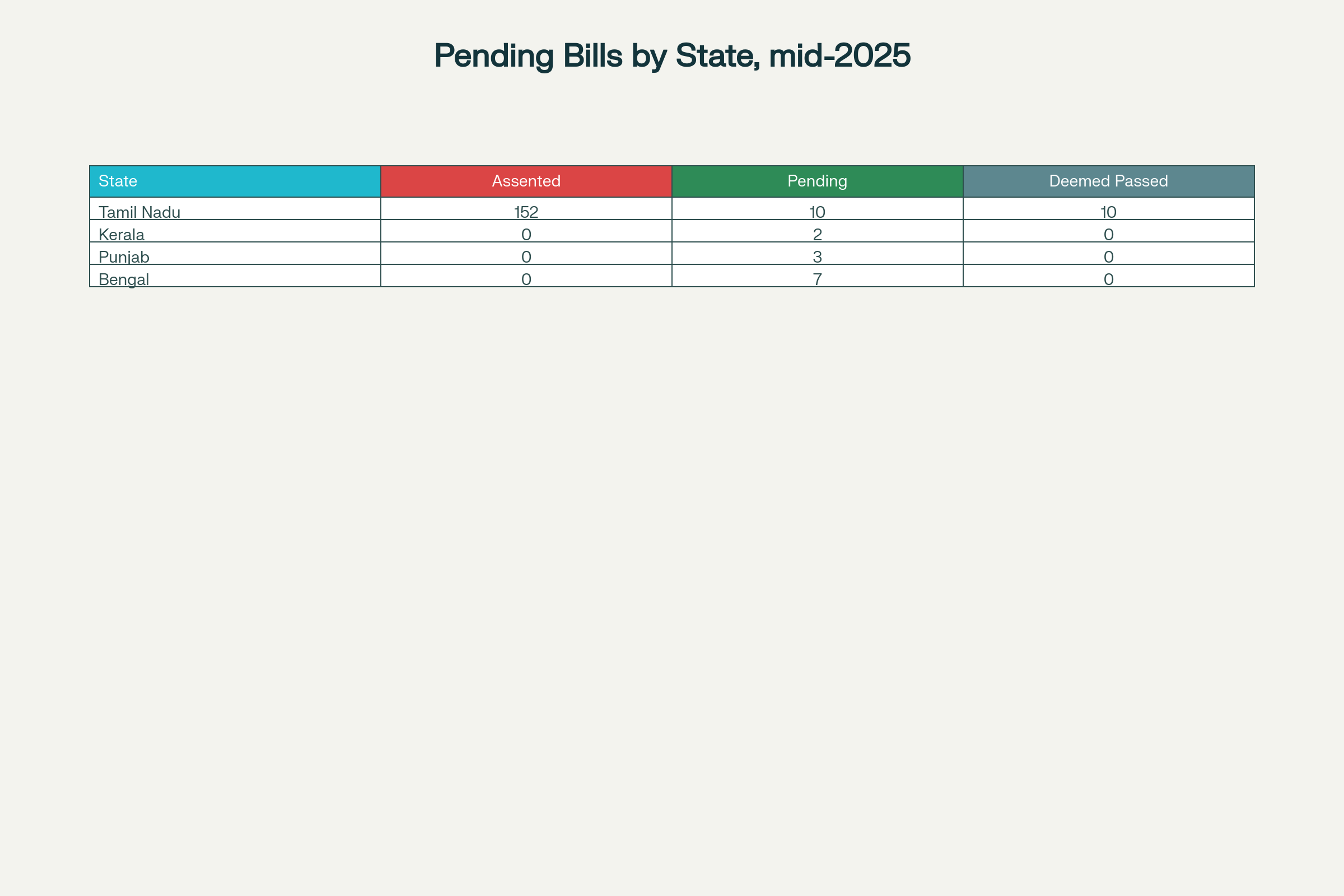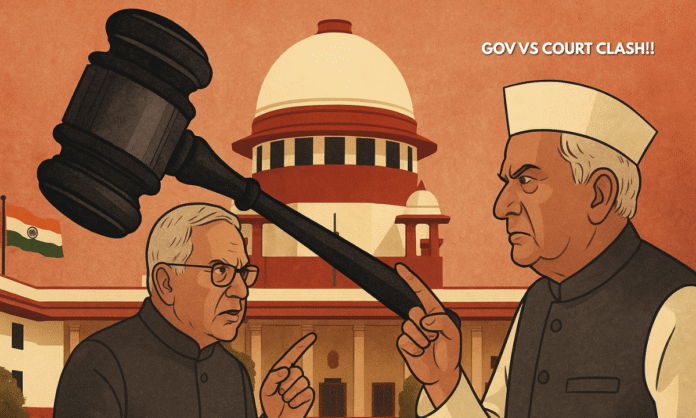Key Highlights:
- Government argues not all constitutional problems require Supreme Court intervention, emphasizing political solutions between Chief Ministers and the Prime Minister or President
- Solicitor General Tushar Mehta challenges court’s authority to impose timelines on governors and President for bill assent in absence of constitutional provisions
- President Droupadi Murmu’s Article 143 reference seeks Supreme Court opinion on 14 constitutional questions regarding executive powers over state bills
Opening Context
The Indian constitutional framework faces a significant test as the Supreme Court governor powers controversy intensifies during the third day of presidential reference hearings. The central government has taken a firm stance, arguing that judicial intervention should not replace political dialogue in resolving disputes between state governments and governors over pending legislation. This position emerges amid growing tensions between opposition-ruled states and governors appointed by the federal government, particularly following the Supreme Court’s landmark April verdict that established strict timelines for bill assent.
Solicitor General Tushar Mehta, representing the Centre, emphasized that Supreme Court governor powers disputes should not automatically translate into judicial solutions, particularly when alternative political mechanisms exist within the constitutional framework. The government’s position challenges the very foundation of the Supreme Court’s April ruling, which deemed indefinite delays by governors as “arbitrary” and “illegal”. This constitutional standoff has far-reaching implications for India’s federal structure and the balance between Supreme Court governor powers and executive authority.
Vice-President Jagdeep Dhankhar conveniently fails to point out that when the Supreme Court of India issues a directive relating to the President of India, it is, in effect, issuing a directive relating to the Union Council of Ministers. In its April 2025 judgment in The State of… pic.twitter.com/ynyyRe4gfc
— N. Ram (@nramind) April 18, 2025
Executive Authority Versus Judicial Oversight in Constitutional Framework
- Article 200 grants governors four distinct options: assent to bills, withhold assent, reserve for presidential consideration, or return to legislature for reconsideration
- Government argues withholding power should be used rarely and only in first instance, as it leads to complete termination of the bill
The constitutional provisions governing bill assent have become the central focus of Supreme Court governor powers debates, with Articles 200 and 201 providing the legal framework for executive action on state legislation. Under Article 200, when a bill passed by state legislature is presented to the governor, they possess discretionary powers that have traditionally operated without judicial timelines. The governor represents the Union of India and is appointed by the President, creating a federal oversight mechanism that the government argues should not be subject to judicial micromanagement.
Solicitor General Mehta emphasized that governors are “not just postmen” but constitutional functionaries representing national interests through presidential appointment. The government’s position reflects broader concerns about separation of powers, arguing that imposing judicial timelines on executive functions undermines constitutional design. This stance directly challenges the Supreme Court governor powers ruling from April, which used Article 142 to establish mandatory timeframes for gubernatorial and presidential action on pending bills.
The debate centers on whether withholding assent constitutes temporary or permanent action, with significant constitutional implications. Government lawyers argue that permanent withholding should remain a viable option for governors when bills conflict with national interests or constitutional provisions, while states contend this creates potential for abuse of Supreme Court governor powers oversight.
Political Solutions Framework Advocated by Central Government
- Direct communication channels exist between Chief Ministers, Prime Minister, and President for resolving bill-related disputes through dialogue
- Delegations regularly approach federal leadership requesting intervention when governors delay decisions on state legislation
The government has outlined a comprehensive political solutions framework as an alternative to Supreme Court governor powers requiring judicial intervention. Solicitor General Mehta detailed existing mechanisms where Chief Ministers can directly approach the Prime Minister or President when governors delay action on bills, emphasizing that “such solutions are taking place, but it is not everywhere”. This approach prioritizes executive-to-executive dialogue over judicial mandates, arguing that constitutional disputes should be resolved through political negotiation rather than court orders.
According to government arguments, the political solutions framework includes formal delegation processes where state representatives can request federal intervention with governors who are sitting on bills. These mechanisms allow for telephone consultations and direct meetings between constitutional functionaries, potentially resolving disputes without judicial involvement. The government maintains that this approach respects federal principles while providing practical solutions to legislative bottlenecks involving Supreme Court governor powers.
The effectiveness of political solutions becomes particularly relevant given the data on pending bills across states. Multiple opposition-ruled states have experienced significant delays, with Tamil Nadu having 10 bills deemed passed by the Supreme Court after prolonged gubernatorial delay. However, the government argues that rushing to court should not be the first response when political channels remain available for dispute resolution regarding Supreme Court governor powers.
Presidential Reference Under Article 143 and Constitutional Questions
- President Droupadi Murmu invoked Article 143(1) seeking Supreme Court advisory opinion on 14 constitutional questions regarding executive powers
- Reference challenges justiciability of executive actions before bills become law and questions court’s authority to impose timelines
The presidential reference represents a crucial moment in Supreme Court governor powers jurisprudence, as President Murmu has formally sought the court’s advisory opinion under Article 143 of the Constitution. This provision empowers the President to consult the Supreme Court on questions of law or fact of public importance, though the resulting opinion remains advisory rather than binding. The reference includes 14 specific questions primarily concerning Articles 200 and 201, and challenges the justiciability of executive actions in the legislative process.
Article 143 creates two categories of presidential references, with the current situation falling under Article 143(1), which allows the President discretionary consultation on matters of public importance. Unlike Article 143(2), which mandates Supreme Court response, the court may choose whether to provide opinion under Article 143(1). The Supreme Court previously declined to provide opinion in 1993 regarding the Ram Janmabhoomi case, demonstrating the discretionary nature of this provision.
The reference specifically questions whether judicial interventions are constitutional given that Articles 200 and 201 do not prescribe timelines for executive action. This challenge directly targets the Supreme Court governor powers April ruling, which used Article 142 to establish binding deadlines for governors and the President. The constitutional significance extends beyond immediate disputes to fundamental questions about separation of powers and judicial limits on executive authority.

Pending Bills Before Governors in Indian States (2025)
Federal Tensions and State-Center Dynamics in Legislative Process
- Multiple opposition-ruled states including Tamil Nadu, Kerala, and Punjab have accused governors of deliberately withholding consent to legislative measures
- Supreme Court’s April verdict affected 10 Tamil Nadu bills that were automatically deemed passed after prolonged delays
The current constitutional crisis reflects deeper federal tensions within India’s Supreme Court governor powers framework, particularly between opposition-ruled states and governors appointed by the federal government. Tamil Nadu, Kerala, and Punjab have formally approached the Supreme Court alleging deliberate obstruction of state legislation by their respective governors. These states argue that governors are using constitutional powers to undermine democratically elected state governments, creating a federal imbalance that threatens constitutional democracy.
Data from the Supreme Court reveals the scope of legislative delays, with Tamil Nadu Governor R.N. Ravi having received 181 bills, of which 152 received assent, five were withdrawn, and 10 remained pending until the court’s intervention. The pattern extends beyond Tamil Nadu, with Kerala having 2 bills pending, Punjab 3 bills, and Bengal 7 bills awaiting gubernatorial action. These statistics demonstrate systematic delays affecting multiple states with common political characteristics regarding Supreme Court governor powers.
The Supreme Court’s intervention through Article 142 powers represents unprecedented judicial involvement in executive functions, with the court essentially granting assent to pending bills when governors failed to act within prescribed timelines. This judicial activism has generated significant debate about constitutional boundaries, with the government arguing that such intervention violates separation of powers principles. The controversy highlights fundamental questions about federal balance and the extent of central oversight over state legislation through Supreme Court governor powers mechanisms.
Final Perspective
The ongoing Supreme Court governor powers controversy represents a defining moment for India’s constitutional framework, testing the delicate balance between judicial oversight and executive authority. The government’s advocacy for political solutions over judicial intervention reflects legitimate concerns about separation of powers, yet the systematic delays in multiple states suggest potential abuse of constitutional provisions. As the presidential reference proceeds, the Supreme Court faces the complex task of providing guidance that preserves constitutional integrity while ensuring effective governance. The resolution of these Supreme Court governor powers disputes will significantly influence federal dynamics and establish precedents for future constitutional disputes between different levels of government.


